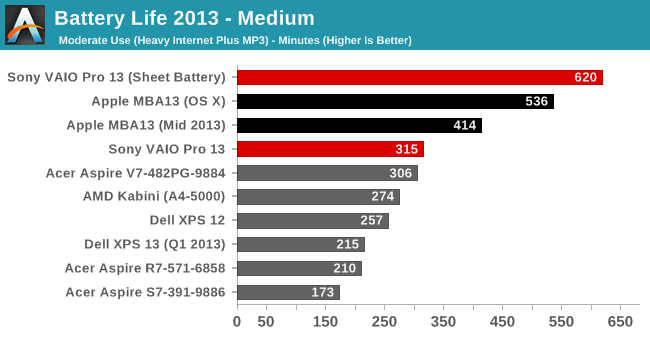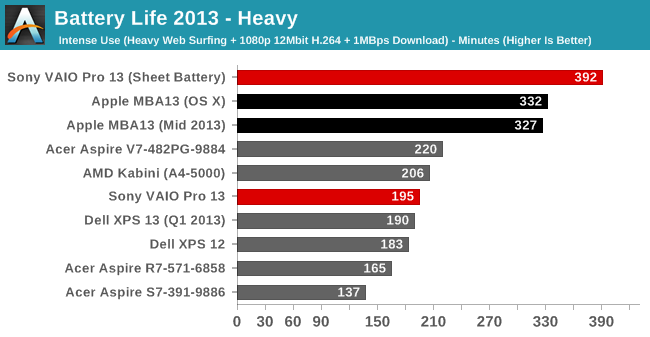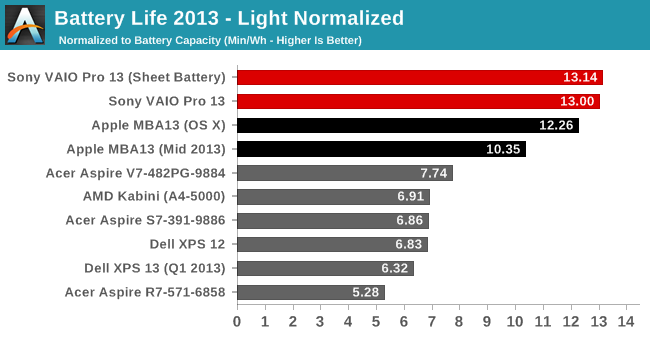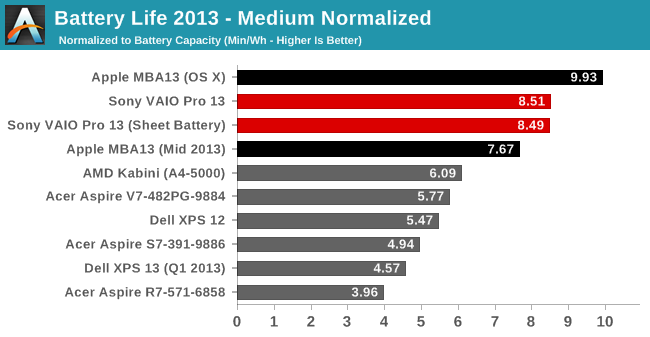Sony VAIO Pro 13: Exceptionally Portable
by Jarred Walton on October 16, 2013 12:00 AM ESTSony VAIO Pro 13: Excellent Battery Life
If the performance in applications wasn't particularly impressive, where Sony positively shines is in their battery life. We have our standard Light, Medium, and Heavy battery life tests, and even the Light test is reasonably demanding (loading four web pages every 60 seconds). We also run the LCD at 200 nits (87% on the VAIO Pro 13), so turning down the brightness will only improve these results.
This is also one of the tests where we can make cross-OS comparisons to Apple's MacBook Air 13. We've seen in the past that OS X gets substantially better battery life with MacBooks than Windows, but we're at least able to run the same workloads so the tests are more or less “fair”. Anand ran the MBA13 under both Windows 8 and OS X, and we've included both results in the charts below. For the VAIO Pro 13, we likewise have results using just the integrated 37Wh battery as well as with the extra sheet battery.






In terms of pure battery life numbers, with the extra battery the Sony VAIO Pro 13 comes in at the top of our charts, but even without the doubling of capacity it does well. In raw battery life, it trails the Haswell-equipped MacBook Air 13 (particularly when the latter is running OS X), and in the Heavy test it also falls behind the Acer V7 and the AMD Kabini prototype. That's only part of the story, however, as the integrated battery is pretty small compared to many of the other laptops in our charts.
Look at the normalized battery life and the VAIO Pro 13 is quite a ways ahead of any other (Windows) contender in the Light and Medium loads. Apple still does better in heavy loads, indicating that Apple is either more aggressive in getting down to lower power C-states, and in OS X Apple also posts an impressive result in our Medium workload. The Heavy load tends to not allow the CPU to relax much (It averages out to around a 20-30% CPU load throughout the test), so it's not too surprising that the MBA13 results are a lot closer to their Win8 results in that particular test.
Adding the sheet battery basically doubles battery life, which puts Sony way ahead of any other laptop we've tested in recent years (though it doesn't change the normalized results). It was almost painful to test battery life, simply because it took so long for the battery to go dead. With the Light dual-battery testing, I started the test, went to bed, came back the next morning and the combined battery charge was still around 50%. If you need even more battery life, you could purchase additional external batteries and swap them quite easily with no downtime, and since Sony has the laptop drain the sheet battery first, you don't need to worry about the integrated battery unexpectedly running out of power.
However you want to look at it, the Sony VAIO Pro 13 delivers on the battery life front. This is how every Haswell laptop should behave, at a minimum. Sadly, we have plenty of examples where this level of power optimization is clearly not in effect, but I'll save that discussion for an upcoming review (cough, Clevo, cough).










106 Comments
View All Comments
JarredWalton - Wednesday, October 16, 2013 - link
Yes, pretty much what you said. There's some VAIO utilities, but they're not too obtrusive and I like some of the features the VAIO Care Center offers (it gives reasonably detailed control over the various settings like the keyboard backlighting among other things). I also uninstalled the McAfee software (we always test without any Firewall enabled and no anti-virus software running, just for consistency). I personally have been using Microsoft Security Essentials on my PCs since it came out and haven't had any problems, but then I avoid the sort of sites that tend to infect PCs so YMMV.jyotib - Wednesday, October 16, 2013 - link
I did buy this machine three months ago, but with a Sony deal that gave a 256GB SSD and 8GB RAM for about the price listed for your review machine. I must say it has been a truly excellent machine for me, as I favour a top flight display, light weight, long battery life and fast operation.The Wi-Fi problem you reference was a real pain, but the Intel driver update has (mostly) sorted it out. It does surface in an unusual way, though. If the machine goes to sleep in one location, and then wakes in a location with a different Wi-Fi router, it does not seem to find it without restarting the Wi-Fi adaptor.
Another update for the display driver now seems to cause the display to get stuck on a low brightness level every now and then - not sure what is going on, as this behaviour was not apparent before the update.
I recognise that the use of carbon fibre has made the Vaio feel flexible, but the design's build quality does not strike me as inadequate in any way. One caveat after 3 months of use is that the keys seem to imprint themselves on the screen so that (at certain angles) I can see key marks on the display. I feel that this is a design problem, caused by the search for a thin device. I did discuss this with Sony and the answer from them was that I needed to use the cloth that came with the device - this black cloth seemed to be part of the packaging but it is quite important, and should not be thrown away. It needs to cover on the keyboard every time you shut the lid. I thought this would be remarkably frustrating and that I would lose the cloth immediately. Somehow, I have got used to it and the cloth is still present three months in. Would I prefer that Sony had sorted out the problem in the design work? Yes, yes.
Overall, I am struck how well my personal experience with the machine reflects the findings of the reviewer. This might be the first time I have read an Anandtech review of a product I already know well - rather than reading about a product I might be considering - and its accuracy in laying out my own use case does encourage me to consider your reviews seriously next time I am seeking a new device. Well done.
monstercameron - Wednesday, October 16, 2013 - link
Jarred why not compare it to a6-5200? the a4-5000 only makes the AMD competition look terrible in comparison.JarredWalton - Wednesday, October 16, 2013 - link
Because we never had one for testing.hughlle - Wednesday, October 16, 2013 - link
I'm just a little comfused by the lack of information in the battery graphs. You might as well just remove the numbers entirely. 959 what's? What am i actually looking at? I can make out the graphs lower down as being rated in hours, but what about the former graphs?JarredWalton - Wednesday, October 16, 2013 - link
They're in minutes... not sure why the subtext no longer says that as I swear it used to be there. I'll fix that....Chrispy_ - Wednesday, October 16, 2013 - link
Mind-boggling expensive for a Dual-core with only 4GB of RAM, a small SSD and the entry-level IGP, portable or not.Is it worth it?
NO. Not even close.
hfm - Wednesday, October 16, 2013 - link
Stop messing around with these other devices and post the p34g review. :)JarredWalton - Wednesday, October 16, 2013 - link
I have to get one other finished first (Clevo W740SU), but the preview should tell you much of what you need to know. I just need to test actually gaming performance and battery life, as well as check for any heat issues. It's a shame their keyboard isn't that great though.hfm - Wednesday, October 16, 2013 - link
How's the cooling system noise under gaming load?